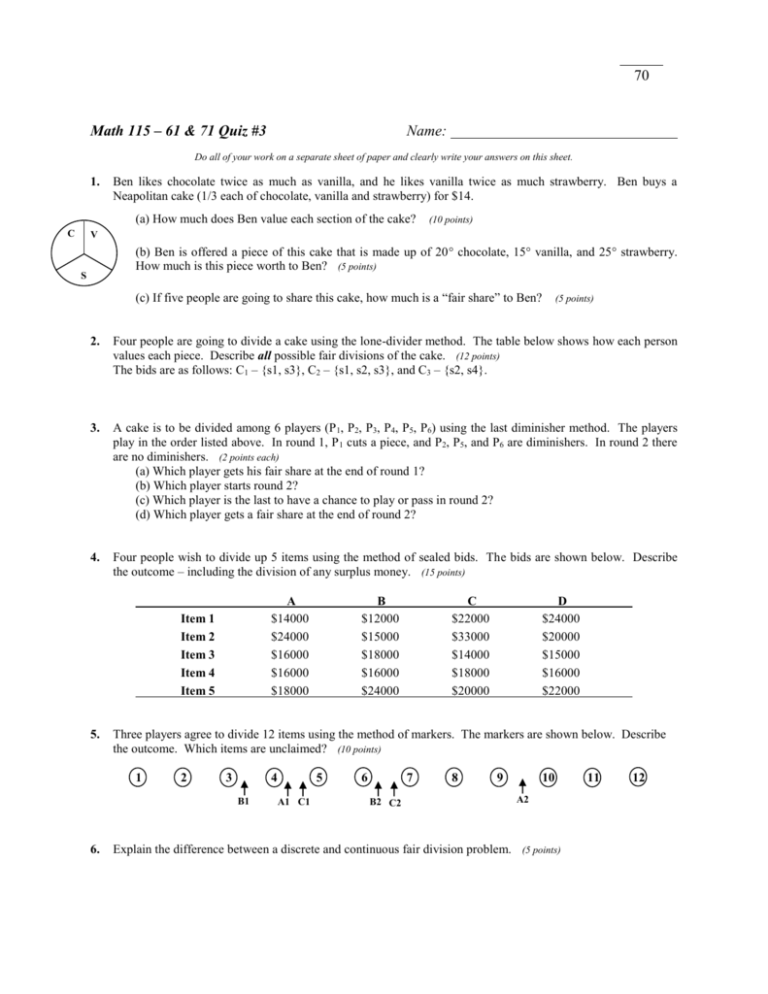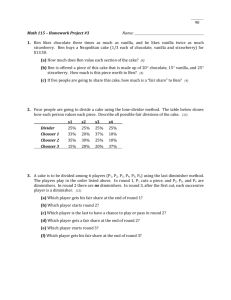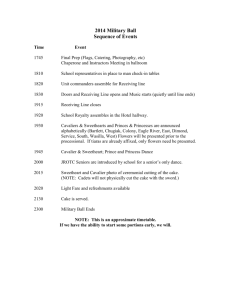Math 115 – 61 & 71 Quiz #3
advertisement

70
Math 115 – 61 & 71 Quiz #3
Name:
Do all of your work on a separate sheet of paper and clearly write your answers on this sheet.
1.
Ben likes chocolate twice as much as vanilla, and he likes vanilla twice as much strawberry. Ben buys a
Neapolitan cake (1/3 each of chocolate, vanilla and strawberry) for $14.
(a) How much does Ben value each section of the cake?
C
(10 points)
V
(b) Ben is offered a piece of this cake that is made up of 20 chocolate, 15 vanilla, and 25 strawberry.
How much is this piece worth to Ben? (5 points)
S
(c) If five people are going to share this cake, how much is a “fair share” to Ben?
(5 points)
2.
Four people are going to divide a cake using the lone-divider method. The table below shows how each person
values each piece. Describe all possible fair divisions of the cake. (12 points)
The bids are as follows: C1 – {s1, s3}, C2 – {s1, s2, s3}, and C3 – {s2, s4}.
3.
A cake is to be divided among 6 players (P 1, P2, P3, P4, P5, P6) using the last diminisher method. The players
play in the order listed above. In round 1, P 1 cuts a piece, and P2, P5, and P6 are diminishers. In round 2 there
are no diminishers. (2 points each)
(a) Which player gets his fair share at the end of round 1?
(b) Which player starts round 2?
(c) Which player is the last to have a chance to play or pass in round 2?
(d) Which player gets a fair share at the end of round 2?
4.
Four people wish to divide up 5 items using the method of sealed bids. The bids are shown below. Describe
the outcome – including the division of any surplus money. (15 points)
A
$14000
$24000
$16000
$16000
$18000
Item 1
Item 2
Item 3
Item 4
Item 5
5.
C
$22000
$33000
$14000
$18000
$20000
D
$24000
$20000
$15000
$16000
$22000
Three players agree to divide 12 items using the method of markers. The markers are shown below. Describe
the outcome. Which items are unclaimed? (10 points)
1
2
3
4
B1
6.
B
$12000
$15000
$18000
$16000
$24000
5
A1 C1
6
7
B2 C2
8
9
10
A2
Explain the difference between a discrete and continuous fair division problem. (5 points)
11
12
Quiz 3 – Answers
1.
(a) C = $8, V = $4, and S = $2
(b)
20
120
15
25
8 120
4 120
2 $2.25
(c) $2.80
2.
D
s3
s4
s2
s4
s2
s1
C1
s1
s1
s1
s3
s3
s3
C2
s2
s3
s3
s1
s1
s2
C3
s4
s2
s4
s2
s4
s4
3.
(a) P6 (b) P1 (c) P5 (d) P1
4.
A: $22000 in cash
B: items 3 and 5 – owes $20750
C: items 2 and 4 – owes $24250
D: items and $250 cash
Surplus = $5687.50 each
5.
A: 10, 11, 12
B: 1, 2, 3
C: 5, 6
Surplus: 4, 7, 8, 9
6.
Discrete – S has item(s) that cannot be “cut up” into smaller pieces
Continuous – S can be cut in any way desired











